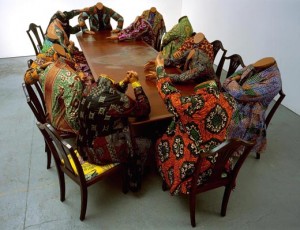Yinka Shonibare, an Artist Turned Professor
/https://tf-cmsv2-smithsonianmag-media.s3.amazonaws.com/filer/Yinka-Shonibare-by-D519875-215x300.jpg)
The past is prologue. And in the hands of the 47-year-old Nigerian artist Yinka Shonibare, history makes for rich fodder in the iconography of his sumptuous sculptural tableaux, curious films, richly imbued paintings and dramatic photographs.
Twenty-one of Shonibare's works are on view in the recently opened retrospective, "Yinka Shonibare MBE" at the National Museum of African Art. Shonibare, who is based in London, is most acclaimed for his ironic and sometimes erotic assemblages of beautifully attired, but headless mannequins. Decked out in the brightly patterned African cloths, known as Dutch Wax fabrics, the headless figures incongruently sport the styles and fashions of 19th-century Europe. It's a deliciously playful multiculturalism that could only come from an individual who grew up in Africa, but was educated in Great Britain.
Yinka Shonibare was born in England in 1962 to Nigerian parents, who returned to Nigeria when the boy was 2 years old. At the age of 17, Shonibare traveled to London to be schooled at the Byam Shaw School of Art. At the age of 19, Shonibare suffered a devastating viral illness that left him partially paralyzed. But his disability has hardly impeded his meteoric rise to international renown. His stats include an honorable mention at the Venice Biennale; the celebrated Turner Prize; and recognition among the collections of Art Institute of Chicago, the Walker Art Center, the Tate Modern and the Smithsonian's African Art Museum.

If one were to study History 101 with the artist Yinka Shonibare as professor, the syllabus would be crammed with references on the French Revolution, European aristocracy, the Age of Enlightenment and African colonialism. Professor Shonibare's history, however, is peppered with weird contemporary flourishes. One of the female mannequins wears an African fabric, but the symbol of the fashion house of Chanel can be detected among the richly intricate and colorful patterns.
The artist, says visiting curator Rachel Kent, is making "political and social commentary cloaked in aesthetics." What she means by that is that when the curtain is pulled back, "it's not so pretty." Kent is a curator at the Museum of Modern Art in Sydney, Australia, where the Shonibare show first originated.
Indeed, a headless dandy tries to sip water from a drinking fountain (Headless Man Trying to Drink, 2005), but can't for the obvious reason that the figure lacks a mouth. The work clearly references the world's growing thirst for clean water in the face of shortages, drought and climatic shifts.
In another, 14 headless heads of state huddle around a Victorian-era conference table. The work is called Scramble for Africa, 2003, and it depicts the 1884-85 formalized division of the African continent among European and world powers. The headless—and witless!—statesmen barter for what Belgian's villainous King Leopold II called "a slice of this magnificent cake."
And in yet another, which Kent describes as "really saucy" (and which museum officials had to carefully construct behind a wall built for discretionary reasons) is an erotic, sexual romp. The figures have all lost their heads and are engaged in an assortment of naughty trysts. Gallantry and Criminal Conversation, 2002, depicts the European Grand Tour, the coming of age journey that the young elites and socialites of the 19th century took to the fashionable European capitals of the time, Venice, Paris and Rome. Here's a hint: adultery back then was called "criminal conversation."
Professor Shonibare's history lesson engages the viewer in all of the inherent contradictions and complexities of our times and times past. It references the oddly bizarre 19th-century globalization of the brightly colored Dutch wax fabrics that originated in Indonesia, but were produced in Europe, and yet embraced by the cultures of West Africa and now have become a source of African identity and national pride. Shonibare's multiculturalism—he says that he dreams in two languages, English and Yoruba, his native Nigerian tongue—coupled with his wry humor and his sardonic commentary turn history upside down and inside out. It's a show that is both fun and funny, and a little frightening, too.
Or, as the show's curator Karen Milbourne says, "it seduces you with irony and beauty."
See a photo gallery of Shonibare's works.
"Yinka Shonibare MBE" is on view through March 7, 2010, at the National Museum of African Art. The exhibition marks a two-year celebration at the museum of the 50-year anniversary of Nigeria's independence. "Nigeria: Then, Now and Forever," is a series of exhibitions, public programs and special events showcasing the arts, culture and people of Nigeria.
/https://tf-cmsv2-smithsonianmag-media.s3.amazonaws.com/accounts/headshot/Beth_Head_Shot_High_Res-14-v2.png)
/https://tf-cmsv2-smithsonianmag-media.s3.amazonaws.com/accounts/headshot/Beth_Head_Shot_High_Res-14-v2.png)